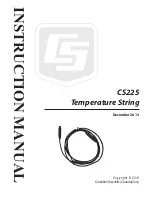
PRO902C MANUAL
T
FS
Rev 6.0
August 16, 2007
2-1
2.0
THEORY OF OPERATION
2.1
General
The PRO902C dilution probe conditioning assembly extracts a continuous sample from a
stack or duct, removes entrained liquids and water vapor, measures oxygen content of the
sample gas, and delivers a clean dry sample for transport to a gas analysis system. The
PRO902C delivers a 4-20 mADC oxygen output signal for data retrieval and produces a
closure (alarm) for low system air pressure.
2.2
Gas flow functional description
A regulated source of instrument air is connected to the dilution eductor jet through the
pressure regulator (PR-1) and pressure gauge (PI-1). The pressure regulator precisely
regulates the air pressure to within 0.04 PSI (.3kPa) for a 10 PSIG (70kPa) change in
input pressure. The flow through the air jet creates a vacuum that pulls the sample gas
through the dilution probe conditioning system and is also used to dilute the sample gas to
lower concentrations: therefore, the air supply quality and pressure are vital for proper
probe operation.
The dilution eductor air flow rate is set and controlled by a dilution critical orifice in the
air jet, operated at 30 PSIG (200kPa) to provide the sample gas critical orifice pressure
drop of 15 inches Hg (50kPa), or greater. The dilution air and sample gas flow rate may
be set by selecting different orifice combinations. Dilution flow rates (between 5 and 10
liters/minute) may be chosen in combination with different process sample gas flow rates
(between 50 and 300 cc/minute) to yield dilution ratios between 16:1 and 100:1. The
process sample gas and dilution air are combined within the eductor, and the diluted
sample gas exits the dilution eductor assembly through the eductor exhaust port.
In the primary sample path (the dilution path), the heated eductor assembly pulls a portion of
the dry, undiluted sample gas from the heat exchanger into the heated eductor sample inlet.
Please see Figure 2.2, probe head flow diagram. It is then carried through a protection filter
and sample critical orifice into the dilution chamber for dilution. The protection filter protects
against particulate matter that may be dislodged during the heated filter replacement.
Installed immediately downstream of the heat exchanger, this one-micron filter protects both
the O2 eductor pump and the heated eductor assembly. The filter does not normally require
maintenance, but visibly indicates when contamination may be present.
The eductor sample critical orifice, contained within the filter/jet cartridge, is fabricated from
quartz. The orifice temperature is maintained at 140.5°C ± 5.5°C (285°F ± 10°F). From the
orifice, the process gas passes to the vacuum cavity of the dilution eductor. The dilution
eductor assembly is heated by an extension of the heated aluminum housing.
From the eductor exhaust port, the diluted process gas passes to a vent bulkhead on the
conditioning assembly enclosure. A portion of the diluted sample is pulled through a sample
Summary of Contents for PRO902C
Page 6: ......
















































